Making political art great again: t. Rutt takes the T.RUMP bus on the road
In the more light-hearted corners of the Internet, it has been jokingly suggested that Donald Trump’s entire bizarre presidential campaign has really just been an elaborate piece of performance art.
That doesn’t seem to be the case, unfortunately – the campaign, while completely baffling and absurd (also often horrifying), seems to be entirely sincere. But Philadelphia-based artists David Gleeson and Mary Mihelic, collectively known as t. Rutt, have made it the focus of some elaborate performance art of their own.
And they started by buying his old campaign tour bus.
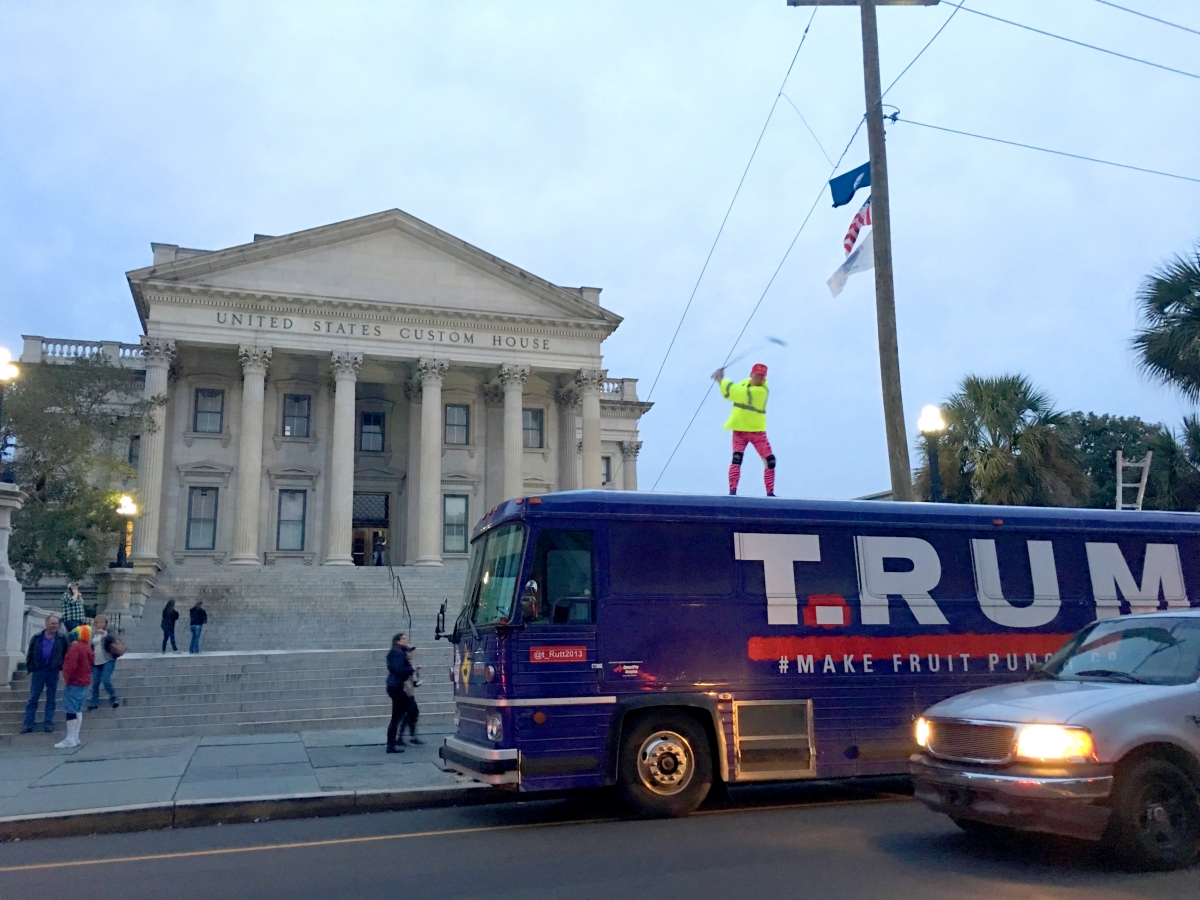
“As an artist I tend to be drawn to things that deal with economics and politics, like addressing issues in the financial system after the last financial crisis using art to de-abstract these abstract problems,” says Gleeson. “It’s an inherently social endeavor. Art is way too underemphasized as a way to understand how we see and move through the world and understand how we behave, because emotion is so much in there. Science is overemphasized as a solution; it’s too clinical.”
Mihelic was also involved in political art, particularly called to it by the story of the schoolgirls who were kidnapped in Nigeria in the spring of 2014.
“I was horrified by it,” she says. “I’m really an advocate of global feminism and believe women should be helping women all over the world. That profoundly affected me.”
At the end of last summer Mihelic happened to see that Donald Trump’s old campaign tour bus was on sale on Craigslist.
“It was too good to be true. I immediately started imagining everything that could happen and called David, who had done work with automobiles before and is a good friend of mine.”
That was the beginning of the artist collective t. Rutt. Since acquiring the T.RUMP bus, they have used it as a platform for political activism in performance art and engaging people of drastically different viewpoints in dialogue.
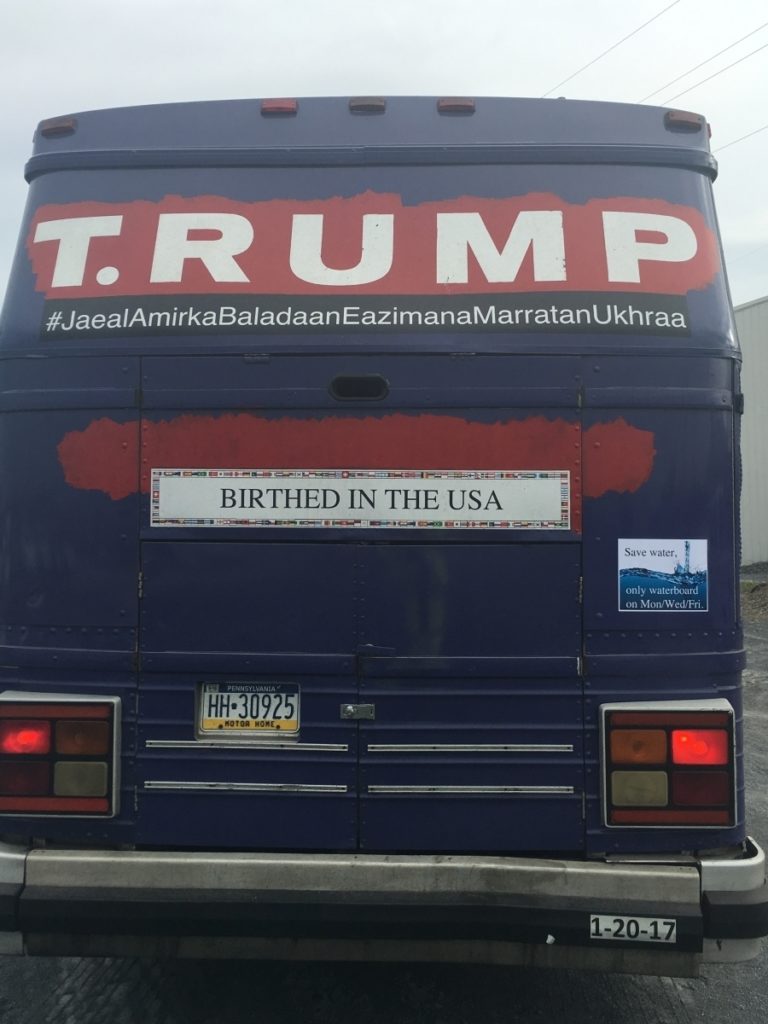
On the outside of the bus, the campaign slogans were changed to “Women Trump Trump” on one side and “Make Fruit Punch Great Again” on the other, the latter a bit of cheekiness that also allows them to disguise the bus at night with large banners advertising “Jeb’s Low Low Energy Fruit Punch” and “Ted’s Extra Christian Cranberry Fruit Punch” to prevent vandalizing. On the back Trump’s tagline “Make America Great Again” is written in Arabic with bumper stickers that read “Birthed in the USA” and “Save Water: Only Waterboard Mondays, Wednesdays, and Fridays.”
Inside the bus all of the Trump campaign artwork remains, with some additions. One installation titled “The Three Wives” examines Trump’s treatment of women. The bus, previously used for bachelor parties before Trump’s campaign, still has a stripper pole in it, which is now used as a barometer for women’s issues. A doublewide seat on the bus is roped off until Scalia is replaced on the Supreme Court. The bathroom wall is covered with Trump University diplomas.
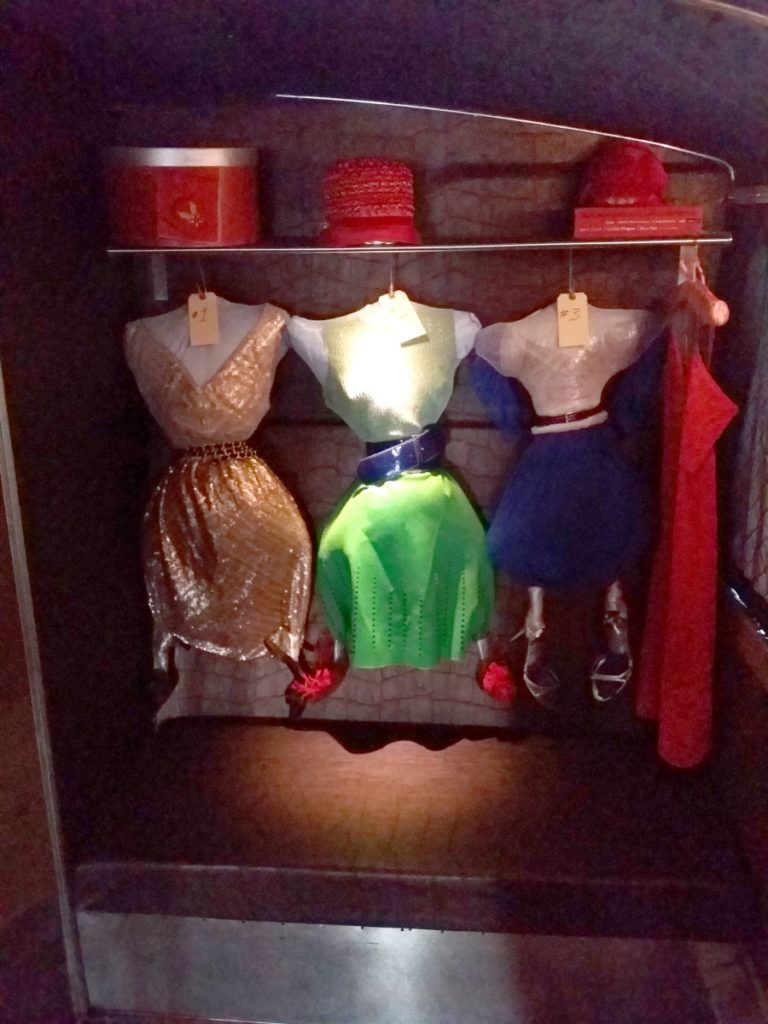
The T.RUMP bus has traveled all over the country, initially to the primary states where they would stop by the town halls and debates in each state, then after the primaries ended and Trump received the Republic National Committee’s nomination, they continued going to his rallies, covering ground from New Hampshire to Los Angeles.
“We’re a constant spectacle creating confusion wherever we go,” says Gleeson. Because the name “TRUMP” is emblazoned across the side of the bus, it is typically mistaken as a pro-Trump bus, which is important for them to be able to engage Trump supporters.
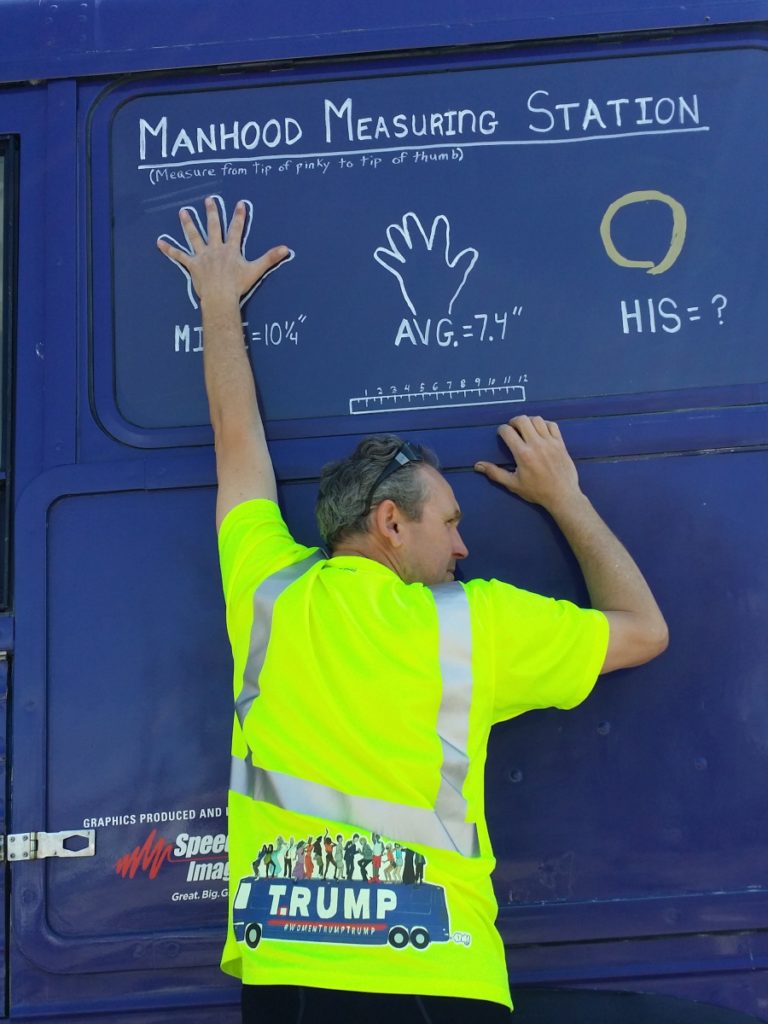
“We’re all about engaging the other side in dialogue,” says Mihelic. “Because Trump supporters think it’s a Trump bus they’ll come over to talk to us, which is really important for the pro-Trumpers’ dialogue because otherwise they wouldn’t approach us. Art is about that emotional shift – people get excited, then they’re disappointed, then they laugh, and if you can change their emotions then you can change their thinking and possibly change their vote.”
It’s an interesting sociological experiment in how people will react to potential conflict if they are first made to feel safe. Gleeson calls it “a new attempt to deal with conflict resolution in art,” while Mihelic simply says it’s fun. “It makes politics fun because the bus has so much humor, and Trump is entertaining.”
But despite the fact that they often use humor to broach difficult subjects, t. Rutt is still most certainly broaching difficult subjects, especially those that are particularly relevant in this election with Trump as a major party’s Presidential nominee.
“Trump comes screaming out of left field and is quite the horrifying character. It seemed unfathomable that he would get the Republican Party’s nomination,” Gleeson says. “We used the bus as a way to document the campaign and some of the crazy things he has said. But for me original impetus was around women’s issues; as a man I am very much looking forward to a woman President. I really feel that as a country we have so much we can achieve and do but we can only do a fraction of it until we incorporate women in the whole spectrum of where decisions are made – politically, religiously.”
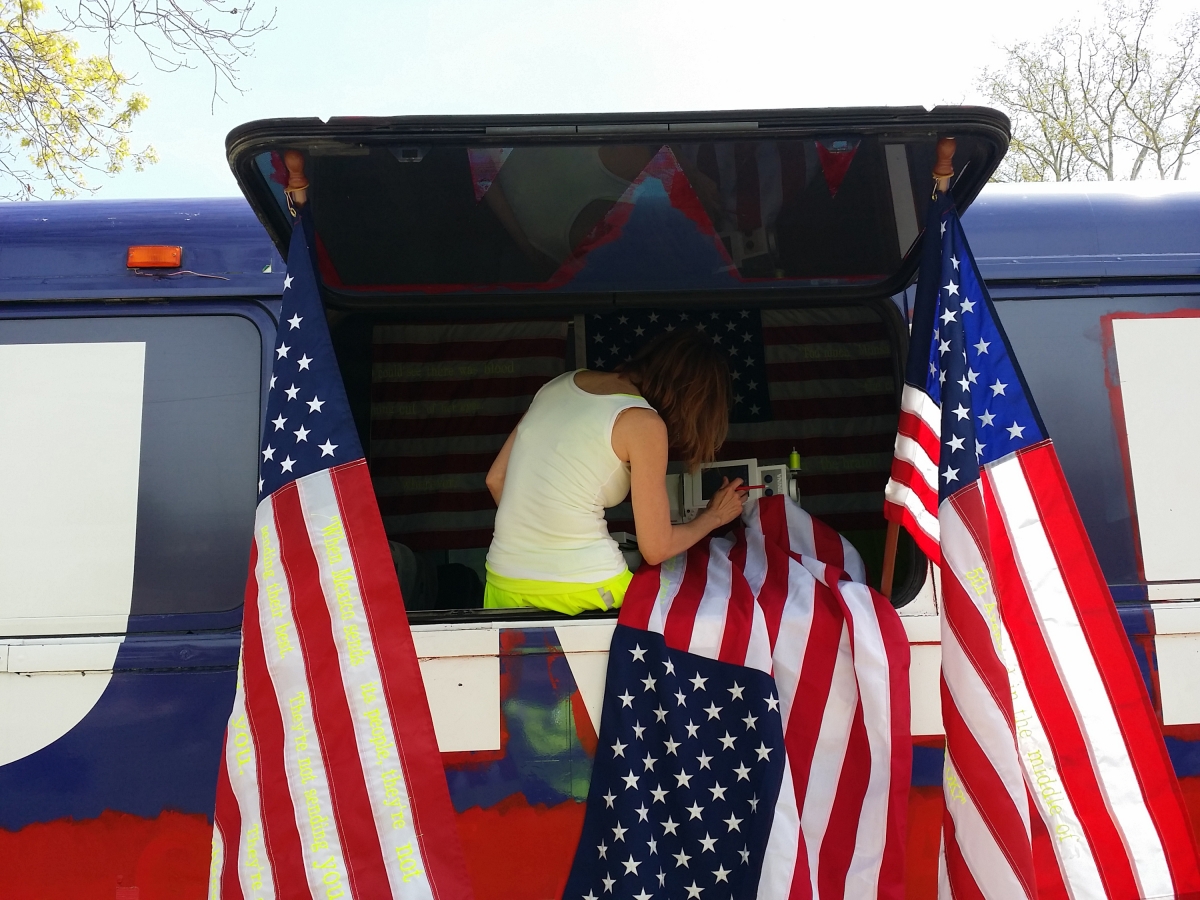
In these final days leading up to the general election, Gleeson and Mihelic are driving around to early voting locations in east coast battleground states displaying their latest piece of Trump-inspired artwork, Desecration. They have been embroidering Trump quotes on American flags since the spring, imagining how the things he has actually said look like written out on the greatest symbol of American freedom and, ostensibly, equality.
They had previously found a giant vintage flag that they held onto for just the right moment; that moment came when Trump’s most controversial quote – yet still not political career-killing – caught on a hot mic was released in early October, in which he brags about sexually assaulting women with the now-infamous sound byte “Grab them by the p**sy.”
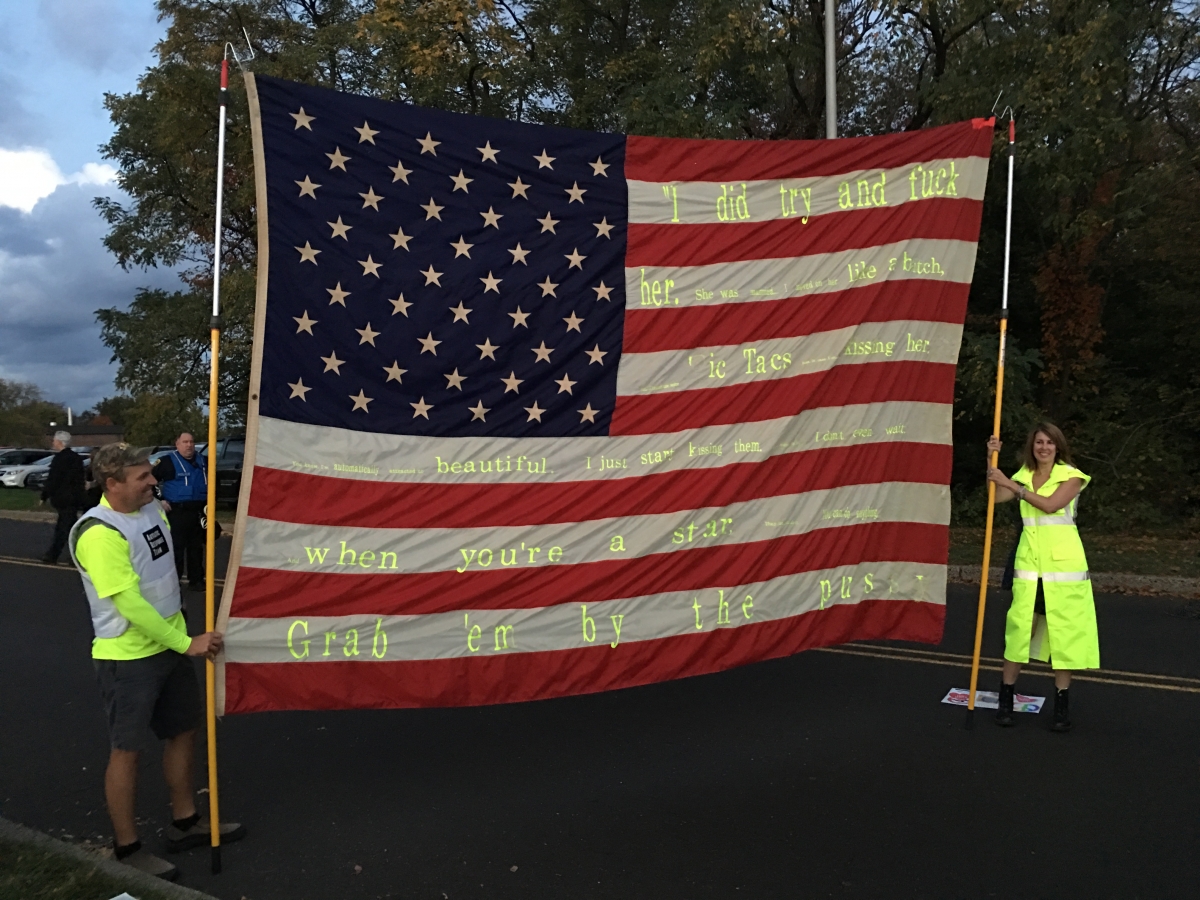
Mihelic embroidered the full quote on this massive flag, which is so large it needs to be displayed on 10-foot poles.
“This is probably one of the most powerful artworks I’ve ever seen in the way people respond to it,” she says. “This was kind of the quote that ended him” – at the time of this conversation that seemed to be the case, but he is once again re-gaining in polls and still has a path to victory, because everything about this election is absurd – “and also a feminist act. We unveiled it at a Trump rally in Pennsylvania and for the first time ever Trump supporters were speechless. They didn’t have anything to say. They were shocked and silent.”
The bus is a roving political art installation piece, and Mihelic and Gleeson also do performances around the bus when they set up at a rally or early voting location. All of the performances, like Desecration, are in response to something Trump has said and things has openly supported or promised to do as President.
Sometimes they’ll “waterboard” the bus.
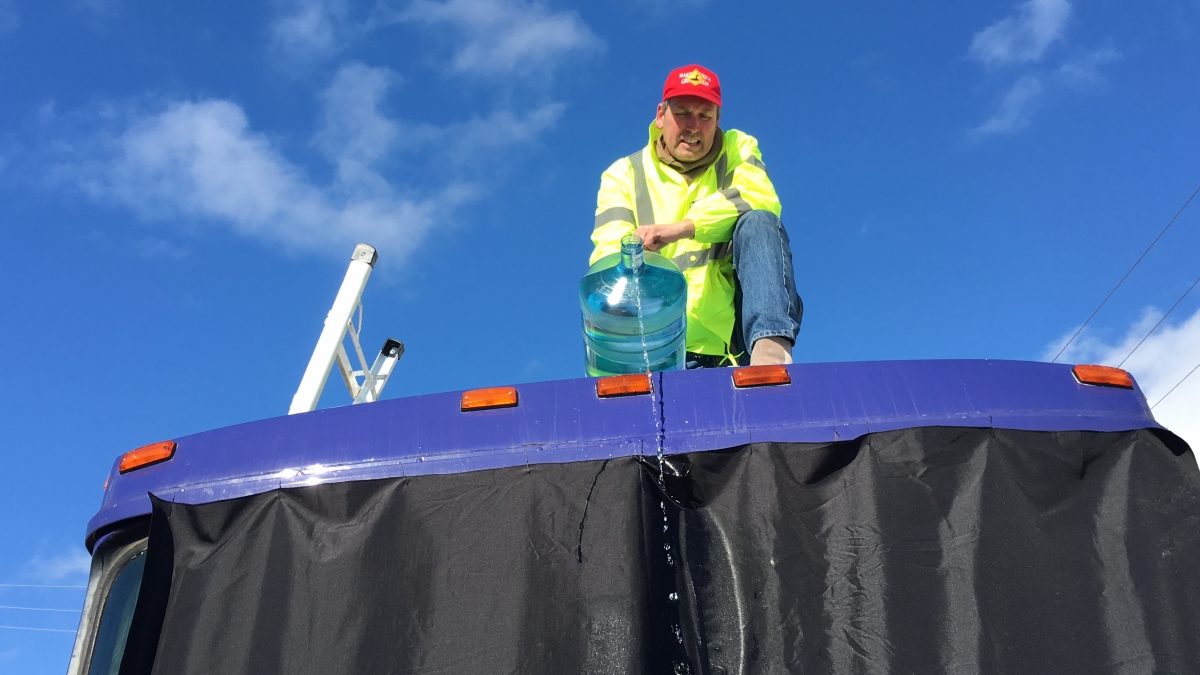
The six-foot-long paintbrush with a scope attached called Open Carry: The Right to Bear Art is a commentary on gun culture in America; ironically they were not allowed to carry it around at the Republican National Convention, despite the fact that 2 million open carry permits were issued for the event.
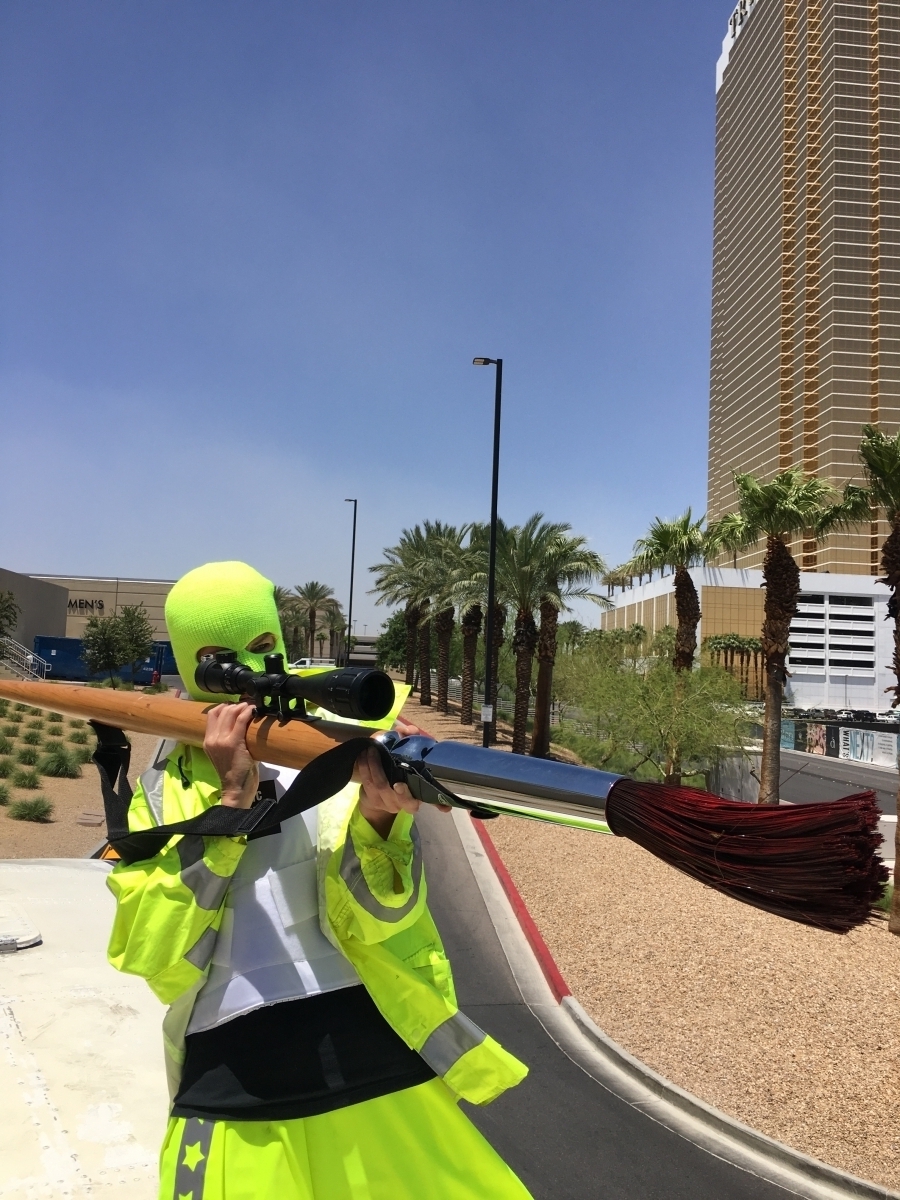
Gleeson will also drive golf balls with Trump’s face on them off the roof of the bus at sunset, a reference to the fact that much of Trump’s empire was built on luxury golf courses yet he is notoriously terrible and a known cheater at golf himself. Gleeson has challenged Trump to a $180,000 golf duel.
t. Rutt also decided to start building the first section of Trump’s “Mexico wall” in Jacumba Hot Springs, California, which they call the American Vetting Wall. Made with 52 cinder blocks and filled with a four-foot-by-eight-foot Trump campaign sign as well as produce and household service products like brooms, hoses, and toilet bowl brushes – a comment on what would happen to the agricultural and service industries if 11 million people largely working in those sectors were to suddenly be deported and the economic impact that would have. They sent a bill for the wall to Mexican President Enrique Peña Nieto.
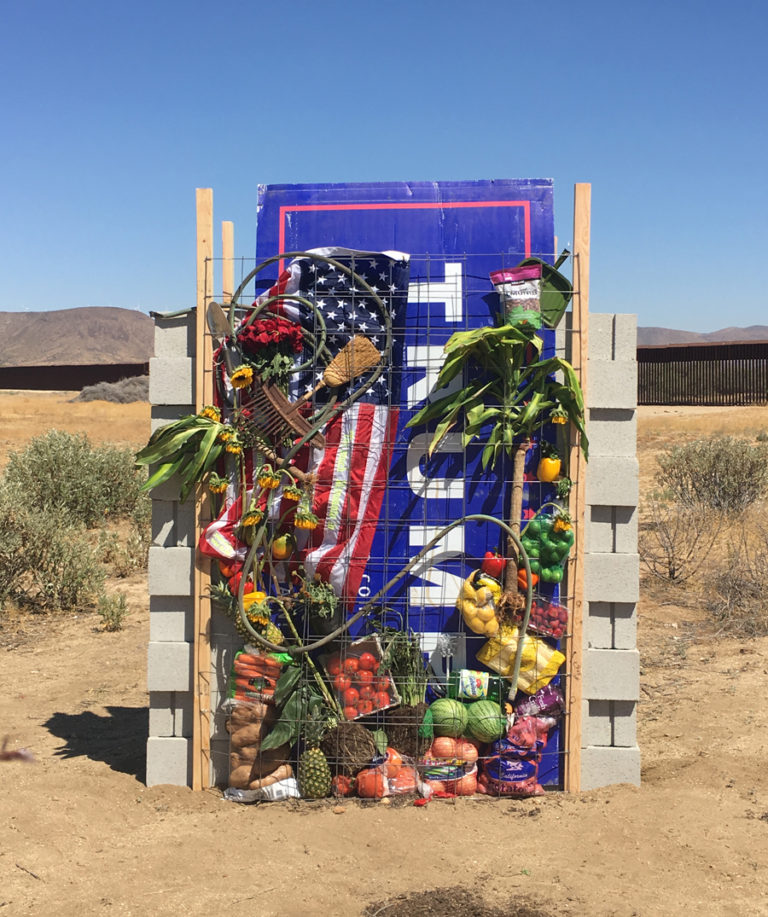
“We’re kind of getting people to really think through these things he has said and the impact it would have on their own lives,” says Gleeson. “It was a really unique and colorful piece. It lasted about a month before people took it.”
There are just a few pieces of dried-out fruit remaining from the original wall. A follow-up to that piece, launching from Trump’s backpedaling promise that he would let “the good ones” back in, is a partial wall with the words “Were you nice, si or no?” written on it and several booties hanging from it – booties that were used by people jumping the wall and discarding them in bushes so as not to leave footprints. On the side facing the United States, the words read, “Are WE nice?” questioning how much we have contributed to creating immigration problems as a policy issue.
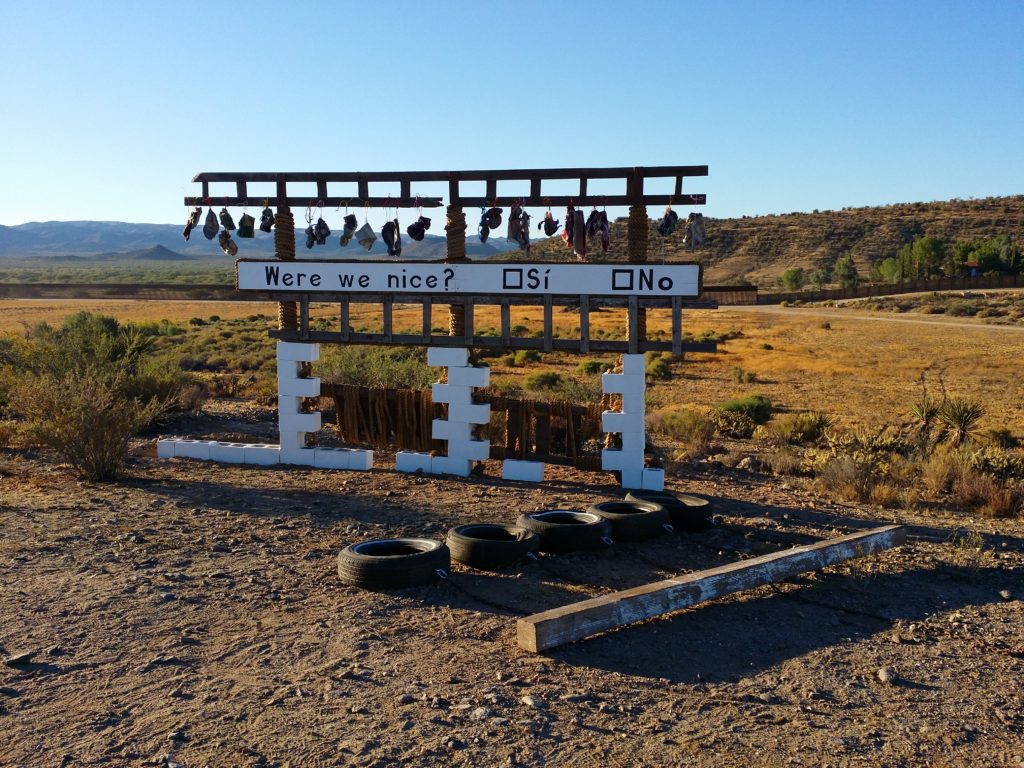
Once the election is over, the T.RUMP bus will live on in some way.
“We may try to find a good spot for the bus at Art Basel,” Gleeson says. “We’d like to see it shown still. I think it’s a great document of this campaign and how crazy it was how close we got to having such an extreme person so close to winning the presidency.”
It should be noted, though, that the election isn’t over yet, and if nothing else has been assured during this campaign season it is that truly anything is possible.
Gleeson continues, “If he wins we should hang it upside down somewhere because he turned the world upside down. If he loses we will try to find ways to continue to exhibit it and use it as a marker in time of how the country had to deal with and process this sort of an event.”
Mihelic adds, “After the election it can really just be much more a piece of artwork in the art world, representing the transformation of the GOP maybe into a better party.”

(1) How do you like to collaborate?
We are both artists and friends and had worked together on a show in New York City once before. Nothing to this extent. Of course, the more you work together the more in sync your ideas become. We spend so many hours on the bus, we have hours and hours to talk about Trump, American culture and politics and bounce ideas around. So we just tend to drive, listen to music and podcasts and brainstorm while on the bus.
(2) How do you start a project?
We both tend to start when we are inspired or unispired by the state of the world around us. For example, after the 276 Nigerian schoolgirls were kidnapped, Mary started a series of artworks about that. When Trump insulted Megyn Kelly during the first debate, David started making art about Trump. Then when Mary saw Trump’s bus went up for sale on Craigslist it was one of those things that was almost too good to be true. We immediately understood the potential of it as a raw material for it as an artwork.
(3) How do you talk about your value?
Value is as much about giving back to society as it is getting value from the art. It is valuable that artists speak out against demagogues, racists, and mysogynists — those who are trying to limit free speech. Our voices are valuable, our talents are valuable — not necessarily monetarily — but as a way to safeguard this nation’s values. We value free speech, democracy and equal rights for everyone. We have learned that the primarily value of the bus is that it provokes direct engagement with the public.
(4) How do you define success?
We define success in many ways. The public defines it for us. Do they engage with the art? When we sewed Donald Trump’s hot mic quote onto a huge American flag and stood outside early voting locations and Trump rallies with it, the success of it as an artwork was clear. Everyone that saw it took a photo. People started talking about the concept of the flag as a symbol and if Trump’s comments belong in the White House. A fight broke out right in front of us as one person was yelling at us about defaming the flag and another cheering our artwork on as fantastic. If it gets people thinking and stokes up emotion, we consider it a great success. And whether we get the finger or the fist pump while driving down the road as other cars react to the bus.
(5) How do you fund your work?
Like most artists, we have to finance our own work. We don’t have the luxury of working as full-time artists and spend time earning money in other jobs.

They are true veterans on the campaign trail now. When I knew them, I don’t think they appreciated my caution about being careful at Trump events (we were all so naiveté in January 2016).
Will this link work? https://youtu.be/PGkWgeMPGqA